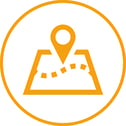The Journey Mapping Experts
Drive business results by mapping and improving customer and employee journeys and the ecosystems that support them
Start MappingUnderstanding Experience by Walking in Your Customer's Shoes
Case Study
Aligning Brand Strategy and Donor Experience to Drive Value
How a customer-experience-driven brand strategy boosted awareness and loyalty, and radically increased donations for this global non-profit charity organization.
Read MoreCase Study
Designing a Better B2B Customer and Partner Experience
How experience mapping helped a global software leader restructure its upgrade process, reduce costs and improve relationships with customers and partners.
Read MoreCase Study
Measuring Customer Experience Reveals Valuable Insights
A community bank’s customer experience mapping initiative allowed it to throw out inaccurate assumptions and meet actual customer needs.
Read MoreMaking Journey Maps Work for You
Done right, journey maps boost business performance
While one of the most widely used tools for understanding customers and employees and improving their experiences, journey maps only work when built in ways that cross organizational silos, are based on defensible insights, and drive action.
McorpCX has built hundreds of journey maps for dozens (upon dozens) of organizations, each with a clear goal in mind: How do we boost business performance through a better understanding of the customer journey?
Journey maps reveal what customers do—and why
Mapping out a customer journey doesn’t have to be complex. Sometimes, a couple of ‘whiteboard and work’ sessions give a team what they need to pluck the low-hanging fruit and markedly improve interactions. McorpCX helps teams work quickly, efficiently, and effectively with these engagements.
Other times, the challenge is bigger. Maybe the easy fixes have been addressed, the journeys are dense, the audiences varied, and the silos too plentiful and fortressed. This is when a partner like McorpCX can help you untangle your journeys and develop action plans for repair. Look inside a Customer Journey Workshop to see if it’s for you.
Whose experience (and what systems) do you want to improve?
Customer Journey Mapping
Re-imagine your customer journeys with thoughtful, focused, outside-in maps that reveal gaps and opportunities.
Employee Journey Mapping
Drive engagement, boost loyalty, and improve the systems and tools that make employees more satisfied and productive.
Buyer Journey Mapping
Linking buyer and seller experience in a journey map helps optimize B2B marketing and sales operations and productivity.
Ecosystem and Capabilities Mapping
Gain cross-functional views of the technology, systems, and data that deliver customer and employee experience.
Learn More About Journey Mapping
What is a journey map?
Journey Maps are visual tools that chart a customer’s interactions and experiences with a company. They paint a detailed picture of their path, capturing emotions, touchpoints, bright spots, and pain points. They are derived from diverse data sources like customer feedback, surveys, and analytics. They represent the customer’s “outside-in” point of view.
Why are journey maps important?
By transforming abstract data into a vivid narrative, Journey Maps allow businesses to truly understand and empathize with their customers, and the experiences they have. They pinpoint areas for improvement, uncover opportunities for innovation, and drive action; they guide businesses in refining journeys, streamlining processes, and devising new ways to delight customers.
What are the key components of a Journey Map?
Key components of a journey map include customer personas, touchpoints, customer emotions, pain points, and opportunities. It should outline the customer's path from initial awareness to post-purchase, highlighting interactions with the business. This visual tool helps identify areas for improvement and enhances customer experience understanding.
What are the objectives of Journey Mapping?
The objectives of Journey Mapping include understanding customer experiences from their perspective, identifying pain points and opportunities for improvement, enhancing customer satisfaction and loyalty, and aligning internal teams towards a customer-centric approach. It aims to optimize interactions and streamline processes to deliver a more efficient and enjoyable customer journey.
How do I build a Customer Journey Map?
To build a customer journey map, start by defining customer personas. Gather data on customer interactions and touchpoints. Analyze the path from awareness to purchase and beyond, noting emotions, pain points, and moments of delight. Visualize this journey, identifying opportunities for improvement to enhance the overall customer experience.
Every change had significant impact. For example, by adding a single missing touchpoint at the loan servicing handoff, we boosted customer satisfaction with the entire process.
Managing Director,
Commercial Debt Division, Global Conglomerate
No other company understands and delivers on customer experience like McorpCX—they drive measurable results, and can prove it. Their expertise and approach are second to none.
Customer Experience Director,
Fortune 500 Technology Firm
Their ability to think strategically about our business (was) synthesized into a framework to drive lasting improvement in the business for customers and partners.
Director of Worldwide Training,
Global Security Software Firm





